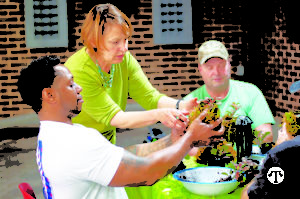Health, Home & Family
 (NAPS)—When it comes to home entertainment, one of the latest innovations in TV viewing is really one of the oldest: the antenna—and budget-conscious consumers are thrilled.
(NAPS)—When it comes to home entertainment, one of the latest innovations in TV viewing is really one of the oldest: the antenna—and budget-conscious consumers are thrilled.
How It Works
These days, with a new smart TV or inexpensive antenna, you can “cut the cord” and discover a vast array of shows and specials, new and nostalgic, via what’s called a diginet or digital subchannel. In 2009, the government changed the way that local stations broadcast their signals, moving them from old-fashioned “analog” signals to newer, more efficient “digital” signals.
That allowed every local broadcast channel to divide up its spectrum into multiple feeds—in the room that it used to take it to air just one channel, it can now air three or four additional digital channels (not just, say, Channel 4, but Channel 4.1, 4.2, 4.3 and so on), while still maintaining high picture quality. Continue reading
 (NAPS)—If you’re like most people, changing the settings on your computer or smartphone can be a frustrating experience, full of technological jargon, confusing menus and complicated controls.
(NAPS)—If you’re like most people, changing the settings on your computer or smartphone can be a frustrating experience, full of technological jargon, confusing menus and complicated controls.
That’s why the digital advertising industry decided to create a simple and intuitive way for people to get information and make choices about certain types of online ads they get. It’s as easy as clicking a blue triangle.
In the corner of many online and mobile ads today, there’s a little blue triangle, sometimes labeled “AdChoices” or “Your AdChoices.” That triangle is known as the YourAdChoices icon, and it can be your gateway to trustworthy information and control over digital ads. Continue reading
 (NAPSI)—Millions of Americans get Social Security disability benefits yet want to work. They may be glad to know about a federal program that can help them enter the workforce while maintaining access to benefits. Thanks to Social Security’s Ticket to Work program, free employment support services help people prepare for work, find jobs or progress in their careers.
(NAPSI)—Millions of Americans get Social Security disability benefits yet want to work. They may be glad to know about a federal program that can help them enter the workforce while maintaining access to benefits. Thanks to Social Security’s Ticket to Work program, free employment support services help people prepare for work, find jobs or progress in their careers.
Many of these people are concerned about what employment would mean for their Supplemental Security Income (SSI) or Social Security Disability Insurance (SSDI) benefits. There’s no need to worry. Social Security Work Incentives make it easier for adults with disabilities to explore work while continuing to receive benefits. Some of these incentives make it possible for people to test their ability to work without immediately losing Medicare or Medicaid coverage. Others let people whose disability interferes with employment start receiving benefits again without needing to submit a new application under certain conditions. Because everyone’s situation is different, job seekers are encouraged to talk with a professional Benefits Counselor. These are trained experts who help people make informed decisions about employment. To find one, call the Ticket to Work Help Line at 1 (866) 968-7842 or 1 (866) 833-2967 (TTY). Continue reading
 (NAPS)—It’s a tragedy: Every day, 22 U.S. veterans take their own lives—a needless loss of 8,000 service members a year.
(NAPS)—It’s a tragedy: Every day, 22 U.S. veterans take their own lives—a needless loss of 8,000 service members a year.
The Problem
Returning veterans may experience divorce, joblessness, homelessness and hopelessness.
The often-devastating effects of mild to moderate traumatic brain injury (mTBI) and post-traumatic stress (PTS), plus the loss of their military community support, can cause a downward spiral.
Symptoms of mTBI include headaches and problems with balance, sleep, vision and memory. Emotional signs include depression and anxiety. But today’s treatment approaches and therapeutic technologies offer hope for veterans feeling overwhelming physical and emotional pain from these invisible wounds of war. Continue reading
Social Security Public Affairs Specialist Social Security and Medicare are both programs that are household names, but do you know the true difference? Both programs help safeguard millions of Americans as well as improve the quality of life for their family and friends. While Social Security offers retirement, disability, and survivors benefits, Medicare provides health insurance.
Medicare is our country’s health insurance program for people age 65 or older and younger people receiving Social Security disability benefits. The program helps with the cost of health care, but it doesn’t cover all medical expenses or the cost of most long-term care.
When you first enroll in Medicare and during certain times of the year, you can choose how you get your Medicare coverage. There are 2 main ways to get Medicare: Continue reading
Social Security Public Affairs Specialist
Scammers have become more aggressive and sophisticated in the digital age. With millions of people relying on Social Security and Medicare, scammers target audiences who are looking for legitimate program and benefit information. Scammers sometimes try to scare people into giving out their personal information. Never give someone who called you any personal information unless you absolutely know who they are.
The law that addresses misleading Social Security and Medicare advertising prohibits people or non-government businesses from using words or emblems that mislead others. Their advertising can’t claim that they represent, are somehow affiliated with, or are endorsed or approved by Social Security or the Centers for Medicare & Medicaid Services (Medicare). Continue reading
 Food Safety Education Staff
Food Safety Education Staff
Press Inquiries (202) 720-9113
Consumer Inquiries (888) 674-6854
WASHINGTON, Aug. 05, 2019 — Summer is coming to an end and families across the country are trading in beach balls and roller blades for backpacks and notebooks. But back-to-school time is also followed by cold and flu season. Having the whole family follow some simple healthy behaviors can help them avoid all kinds of illnesses this time of year, including a topic we get lots of questions about: foodborne illness. Proper handwashing is the best thing you can do to stop the spread of germs and avoid getting your little ones sick.
“USDA research in collaboration with RTI International and NC State University has found that consumers are failing to properly wash their hands 97 percent of the time.” said Dr. Mindy Brashears, Deputy Under Secretary Food Safety. “Washing hands is one of the most effective ways to prevent illness, including foodborne illness.”
Be sure that everyone follows these steps: Continue reading
Dole Fresh Vegetables Announces Precautionary Limited Recall of Baby Spinach
Company Announcement Date: August 09, 2019
FDA Publish Date: August 09, 2019
Product Type: Food & Beverages
Reason for Announcement: Potential Salmonella contamination
Company Name: Dole Fresh Vegetables, Inc.
Brand Name: Dole
Product Description: Baby Spinach
Company Announcement
Dole Fresh Vegetables, Inc. is voluntarily recalling a limited number of cases of baby spinach. The products being recalled are 6 oz Dole Baby Spinach bag, Lot code W20308A (UPC code 0-71430-00964-2), and 10 oz Dole Baby Spinach clamshell, Lot code W203010 (UPC code 0-71430-00016-8), both with Use-by dates of 08-05-2019, due to a possible health risk from Salmonella. Dole Fresh Vegetables is coordinating closely with regulatory officials. No illnesses have been reported in association with the Recall.
The lot code and Use-by date are located on the upper right corner of the bag or on the top label of the clamshell; the UPC code is located on the bottom left corner of the back of the bag or on the bottom label of the clamshell. The impacted products were distributed in IL, IN, KY, MI, NJ, NY, OH, TN, VA, and WI. This product is expired and should no longer be on retail shelves. Consumers are advised to check product they have in their homes and discard any product matching these lot and UPC codes and Use-by dates. Continue reading
 (NAPSI)—As you may have discovered, looking for work is not a one-size-fits-all journey. That’s why the Ticket to Work (Ticket) program, Social Security’s national employment-related program, uses a customized approach to help people with disabilities find meaningful work that leads to financial independence.
(NAPSI)—As you may have discovered, looking for work is not a one-size-fits-all journey. That’s why the Ticket to Work (Ticket) program, Social Security’s national employment-related program, uses a customized approach to help people with disabilities find meaningful work that leads to financial independence.
How It Works
The Ticket program supports career development for people ages 18 through 64 who get Social Security disability benefits (SSI or SSDI) and want to work. The individualization begins when a beneficiary and a service provider agree to work together. The service provider and beneficiary work one on one to develop an Individual Work Plan (IWP), a detailed road map that identifies employment goals based on where the individual is on the path to work. This process, as well as other services, can be done either in person or virtually. The IWP also includes services that the participants will need to prepare for jobs tailored to their capabilities and strengths. Continue reading
(NAPSI)—If any of the nearly 57 million elementary and high school students in America is someone you care about, there could be good news for you.
Schools today have discovered some wonderful new ways to make learning something kids want to do and school a place they want to be.
These engaging, 21st century classrooms are powered by modern, digital curriculum and content that helps create real-world learning experiences.
What It Does
As a result, studies show that students with access to high-quality digital curriculum resources from Discovery Education, one of the world’s leading education companies, outpace their peers on state assessments in reading, mathematics and social studies, and have higher school attendance rates than those that don’t have access to these resources. In particular:
- Hispanic students attended an average of three more days per year
- Students affected by poverty attended an average of six more days per year
- Students with disabilities attended an average of 12 more days per year.


